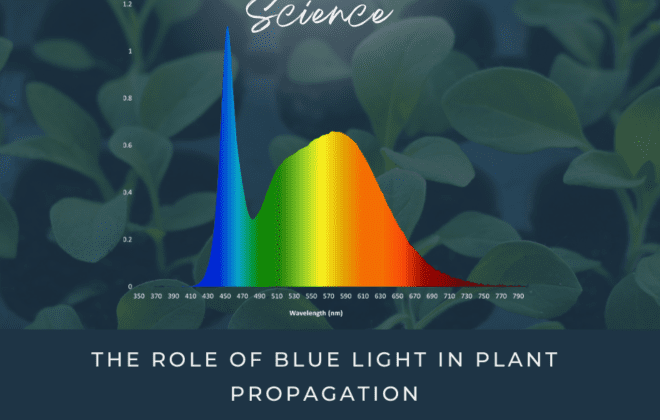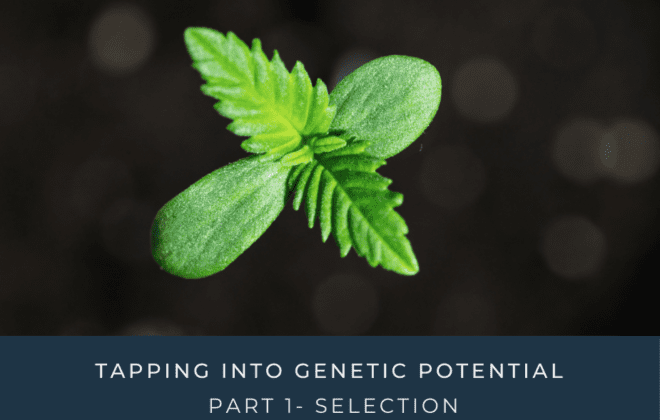TAPPING INTO GENETIC POTENTIAL PART TWO: MANIPULATING THE SUN

When it comes to bringing out a plant’s genetic potential, indoor cultivators can learn a lot from nature. The rotation of the sun, and all of its different wavelengths, helps plants naturally express their notable attributes through photosynthesis.
Photosynthesis is the process in which green plants use sunlight to synthesize foods from carbon dioxide and water, which is necessary for healthy plant production.
While the sun has done a fantastic job of growing the cannabis plant efficiently in nature, when it comes to commercial production of the plant a few rainy days could mean a major profit loss and inconsistent dosage to your customers.
With the influx of indoor cultivation for commercial purposes in the past 10 years as cannabis regulations loosen up globally, cultivators are searching for one thing- replicable consistency.
But why stop there? More than just replicate the sun’s functionality – top-tier horticultural LED lighting technology can enhance par levels from the sun and make for a perfect day, every day.
REMOVE THE GUESSWORK:
Just like the sun, if you apply any light to a green plant indoors photosynthesis will occur to some degree. From this logic, metal halide, CMH, and HPS lights were born. Without getting into specifics, each one of these bulbs has its own specific spectrum and purpose. Overtime cultivators and scientists alike learned that, while these lights did grow their cannabis well, through new tech they can give growers the ability to manipulate the spectrums to develop exactly what a cultivar needs to excel.
There was one small snag, putting spectrum manipulation in the hands of the grower instead of the engineer leads to some undesired manipulation and further inconsistencies in the final product. This is why, companies like Aelius LED, fine-tune the spectrum for growers leading to a consistent flow of only the parts of the sun’s spectrum that will bring out the best version of your plant.
Having an in-depth understanding of how each of the wavelength’s functions helps LED lighting companies not only mimic but maximize the indoor lighting conditions for the desired consistent performance. Advances in LED technology are continually evolving, which is why it is vital to partner with an equipment provider that is invested in research. This includes developing and researching new ways to not only remove variables but add and tweak spectrums to enhance the plant.
 DELVING INTO SPECTRUM MANIPULATION:
DELVING INTO SPECTRUM MANIPULATION:
Every plant goes through five photo-sensory systems, understanding the function of each of these systems can help growers understand what their lighting environment should be for optimal genetic performance. These photo-sensory systems are responsible for communicating to your plant what it should do and when. For example, when an abundance of far-red light is detected, a plant assumes it is in the shade, as a result, the plant grows taller to move away from the shade. This is why growers using our Matrx REDD and Aelius REDD are able to produce taller plants than they would with other products. Recreating these situations in an indoor environment through spectrum manipulation allows for customized results that can be replicated across your commercial platform. It is this that truly sets LED apart from other indoor lighting solutions.
Modifications to lighting can change everything down to the actual architecture of the plant, allowing, for example, a mother plant to produce more shoots to obtain viable clones from.
Adjusting the spectral quality, irradiance, intensity, and photoperiod of the light can play a key role in the overall development of the cannabis plant.
Cannabis research has made large strides into how LED technology can be used to stimulate key genetic attributes of the plant. In a recent study conducted by Bernstein and Danzinger, they discovered that the highest yields of the plant occurred when the light spectrum was restricted to the red and blue range. Their findings didn’t stop there, their research also revealed that the ratio of blue to red light affects cannabinoid metabolism. For example, CBGA accumulation in the plant appeared to be stimulated with blue-rich light.
LED lighting companies, like Aelius LED use this information and research to create a diverse number of solutions designed to unlock custom genetic features of your cultivar. As the research advances, so will the technology. Placing your hat in the ring with an LED company that keeps up with tech and offers incentives to trade up will make sure your crop is not only consistent but consistently the best.


 DELVING INTO SPECTRUM MANIPULATION:
DELVING INTO SPECTRUM MANIPULATION:

